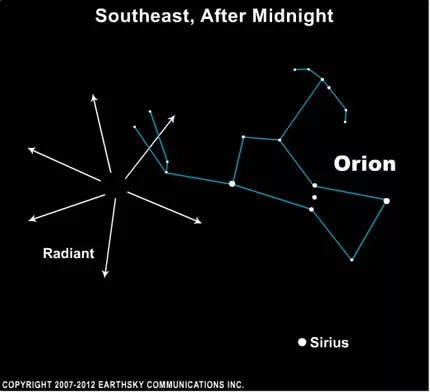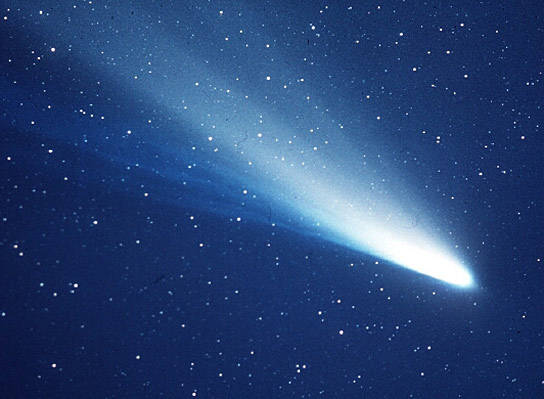View Other Topics.
 Oct 21, 2016
Oct 21, 2016
In 2016, EarthSky.com tells us, the annual Orionid meteor shower is expected to rain down the greatest number of meteors before dawn on October 21 – though, unfortunately, under the light of the waning gibbous moon. On a dark, moonless night, 10 to 20 meteors per hour can be seen at this shower’s peak.
What are the prospects for this year’s Orionid shower? In 2016, moonlight obtrudes on the show. The best time to watch is in the dark hours before dawn, but keep in mind that the moon will be shining at this hour.
In any year, the Orionids don’t really begin to streak the nighttime sky until late evening, when the magnificent constellation Orion ascends over the eastern horizon. After their radiant point rises, you’ll see many more meteors, and, as the radiant rises higher in the sky throughout the night, the meteors will increase in number. That’s why the wee hours before dawn are usually the best.
With the moon in the predawn sky in 2016, shining right over the constellation Orion, this year will be a tough one for watching the Orionids. Lie down on a reclining lawn chair in comfort and look up! Give yourself at least an hour of watching time for meteors tend to come in spurts, and are interspersed by lulls.
Remember, also, that it takes about twenty minutes for your eyes to adapt to the dark.
Where do I look in the sky to see the Orionids? Meteors in annual showers are named for the point in our sky from which they appear to radiate. The radiant point for the Orionids is in the direction of the famous constellation Orion the Hunter. Hence the name Orionids.
If you trace the paths of these Orionid meteors backward, they seem to come from the Club of Orion. And this year, in 2016, the waning gibbous moon will be very close to Orion’s Club! You might know Orion’s bright, ruddy star Betelgeuse. The radiant is north of Betelgeuse.
But you don’t need to know this constellation to see the meteors. The meteors often don’t become visible until they are 30 degrees or so from their radiant point – and remember, they are streaking out from the radiant in all directions. So the meteors will appear in all parts of the sky.
That’s why it’s best to find a wide-open viewing area than to look in any particular direction. Sometimes friends like to watch together, facing different directions. When somebody sees one, they can call out “Meteor!”
How many Orionid meteors will I see? The word shower might give you the idea of a rain shower. But few meteor showers resemble showers of rain. The Orionids are a relatively modest shower, offering about 10 to 20 meteors per hour on a dark, moonless night.
Meteor showers are more subtle than rain showers, and the Orionid shower isn’t as rich a meteor shower as, for example, the Perseids in August or the Geminids in December.
Orionid meteors are known to be fast and usually on the faint side. But the Orionids can sometimes surprise you with an exceptionally bright meteor – one that would be visible, even on a moonlit night – that might break up into fragments.
For me … even one meteor can be a thrill. But you might want to observe for an hour or more, and in that case the trick is to find a place to observe in the country. Bring along a blanket or lawn chair and lie back comfortably while gazing upward.
What are meteors, anyway? Meteors are fancifully called shooting stars. Of course, they aren’t really stars. They’re space debris burning up in the Earth’s atmosphere.
The Orionid meteors are debris left behind by Comet Halley. The object in the photo above isn’t a meteor. It’s that most famous of all comets – Comet Halley – which last visited Earth in 1986. This comet leaves debris in its wake that strikes Earth’s atmosphere most fully around October 20-22, while Earth intersects the comet’s orbit, as it does every year at this time.

Halley’s Comet, perhaps the most famous of all comets,
is parent of both the Eta Aquarid meteor shower in May and
October’s Orionid meteor shower. Image via NASA.
Particles shed by the comet slam into our upper atmosphere, where they vaporize at some 100 kilometers – 60 miles – above the Earth’s surface.
The Orionids are extremely fast meteors, plummeting into the Earth’s atmosphere at about 66 kilometers – 41 miles – per second. Maybe half of the Orionid meteors leave persistent trains – ionized gas trails that last for a few seconds after the meteor itself has gone.
Bottom line: In 2016, the Orionid meteor shower is expected to rain down its greatest number of meteors on the morning of October 21, though under the light of a bright waning gibbous moon.
Tags:
#Orionid,##orionid#showers,#orionid#meteors,#comet#halley,#meteor#shower,#strz#astrologers,#starzpsychics.com,#starz#advisors,#earthsky.com
Orionids.

In 2016, EarthSky.com tells us, the annual Orionid meteor shower is expected to rain down the greatest number of meteors before dawn on October 21 – though, unfortunately, under the light of the waning gibbous moon. On a dark, moonless night, 10 to 20 meteors per hour can be seen at this shower’s peak.
What are the prospects for this year’s Orionid shower? In 2016, moonlight obtrudes on the show. The best time to watch is in the dark hours before dawn, but keep in mind that the moon will be shining at this hour.
In any year, the Orionids don’t really begin to streak the nighttime sky until late evening, when the magnificent constellation Orion ascends over the eastern horizon. After their radiant point rises, you’ll see many more meteors, and, as the radiant rises higher in the sky throughout the night, the meteors will increase in number. That’s why the wee hours before dawn are usually the best.
With the moon in the predawn sky in 2016, shining right over the constellation Orion, this year will be a tough one for watching the Orionids. Lie down on a reclining lawn chair in comfort and look up! Give yourself at least an hour of watching time for meteors tend to come in spurts, and are interspersed by lulls.
Remember, also, that it takes about twenty minutes for your eyes to adapt to the dark.
Where do I look in the sky to see the Orionids? Meteors in annual showers are named for the point in our sky from which they appear to radiate. The radiant point for the Orionids is in the direction of the famous constellation Orion the Hunter. Hence the name Orionids.
If you trace the paths of these Orionid meteors backward, they seem to come from the Club of Orion. And this year, in 2016, the waning gibbous moon will be very close to Orion’s Club! You might know Orion’s bright, ruddy star Betelgeuse. The radiant is north of Betelgeuse.
But you don’t need to know this constellation to see the meteors. The meteors often don’t become visible until they are 30 degrees or so from their radiant point – and remember, they are streaking out from the radiant in all directions. So the meteors will appear in all parts of the sky.
That’s why it’s best to find a wide-open viewing area than to look in any particular direction. Sometimes friends like to watch together, facing different directions. When somebody sees one, they can call out “Meteor!”
How many Orionid meteors will I see? The word shower might give you the idea of a rain shower. But few meteor showers resemble showers of rain. The Orionids are a relatively modest shower, offering about 10 to 20 meteors per hour on a dark, moonless night.
Meteor showers are more subtle than rain showers, and the Orionid shower isn’t as rich a meteor shower as, for example, the Perseids in August or the Geminids in December.
Orionid meteors are known to be fast and usually on the faint side. But the Orionids can sometimes surprise you with an exceptionally bright meteor – one that would be visible, even on a moonlit night – that might break up into fragments.
For me … even one meteor can be a thrill. But you might want to observe for an hour or more, and in that case the trick is to find a place to observe in the country. Bring along a blanket or lawn chair and lie back comfortably while gazing upward.
What are meteors, anyway? Meteors are fancifully called shooting stars. Of course, they aren’t really stars. They’re space debris burning up in the Earth’s atmosphere.
The Orionid meteors are debris left behind by Comet Halley. The object in the photo above isn’t a meteor. It’s that most famous of all comets – Comet Halley – which last visited Earth in 1986. This comet leaves debris in its wake that strikes Earth’s atmosphere most fully around October 20-22, while Earth intersects the comet’s orbit, as it does every year at this time.

Halley’s Comet, perhaps the most famous of all comets,
is parent of both the Eta Aquarid meteor shower in May and
October’s Orionid meteor shower. Image via NASA.
Particles shed by the comet slam into our upper atmosphere, where they vaporize at some 100 kilometers – 60 miles – above the Earth’s surface.
The Orionids are extremely fast meteors, plummeting into the Earth’s atmosphere at about 66 kilometers – 41 miles – per second. Maybe half of the Orionid meteors leave persistent trains – ionized gas trails that last for a few seconds after the meteor itself has gone.
Bottom line: In 2016, the Orionid meteor shower is expected to rain down its greatest number of meteors on the morning of October 21, though under the light of a bright waning gibbous moon.
Share this article with friends!
Tags:
#Orionid,##orionid#showers,#orionid#meteors,#comet#halley,#meteor#shower,#strz#astrologers,#starzpsychics.com,#starz#advisors,#earthsky.com






